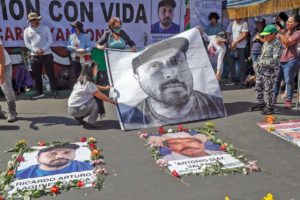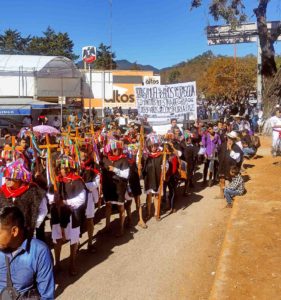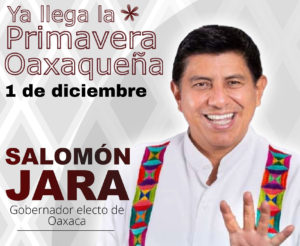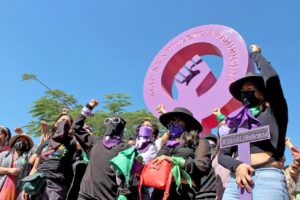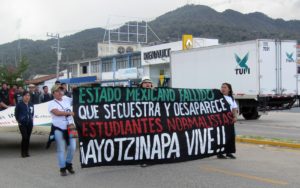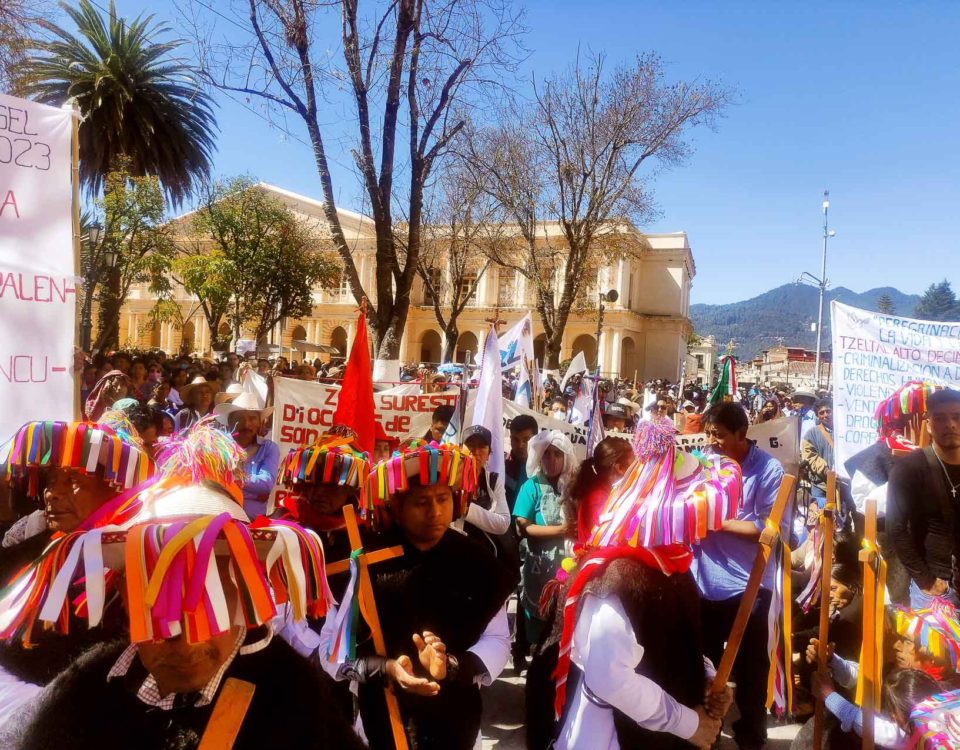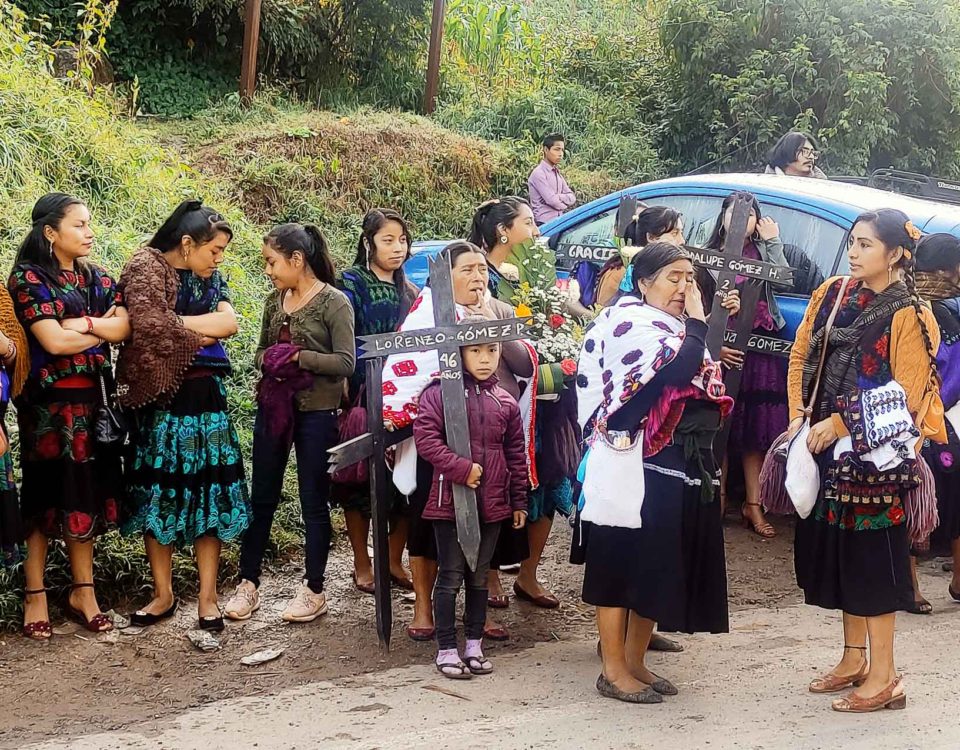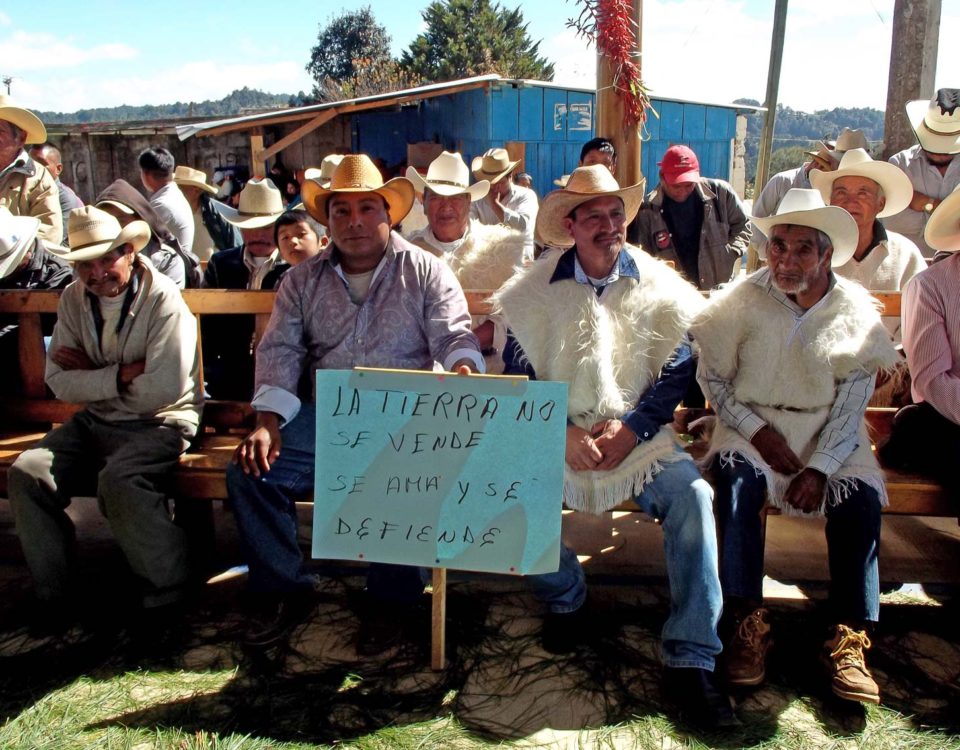2022
09/02/2023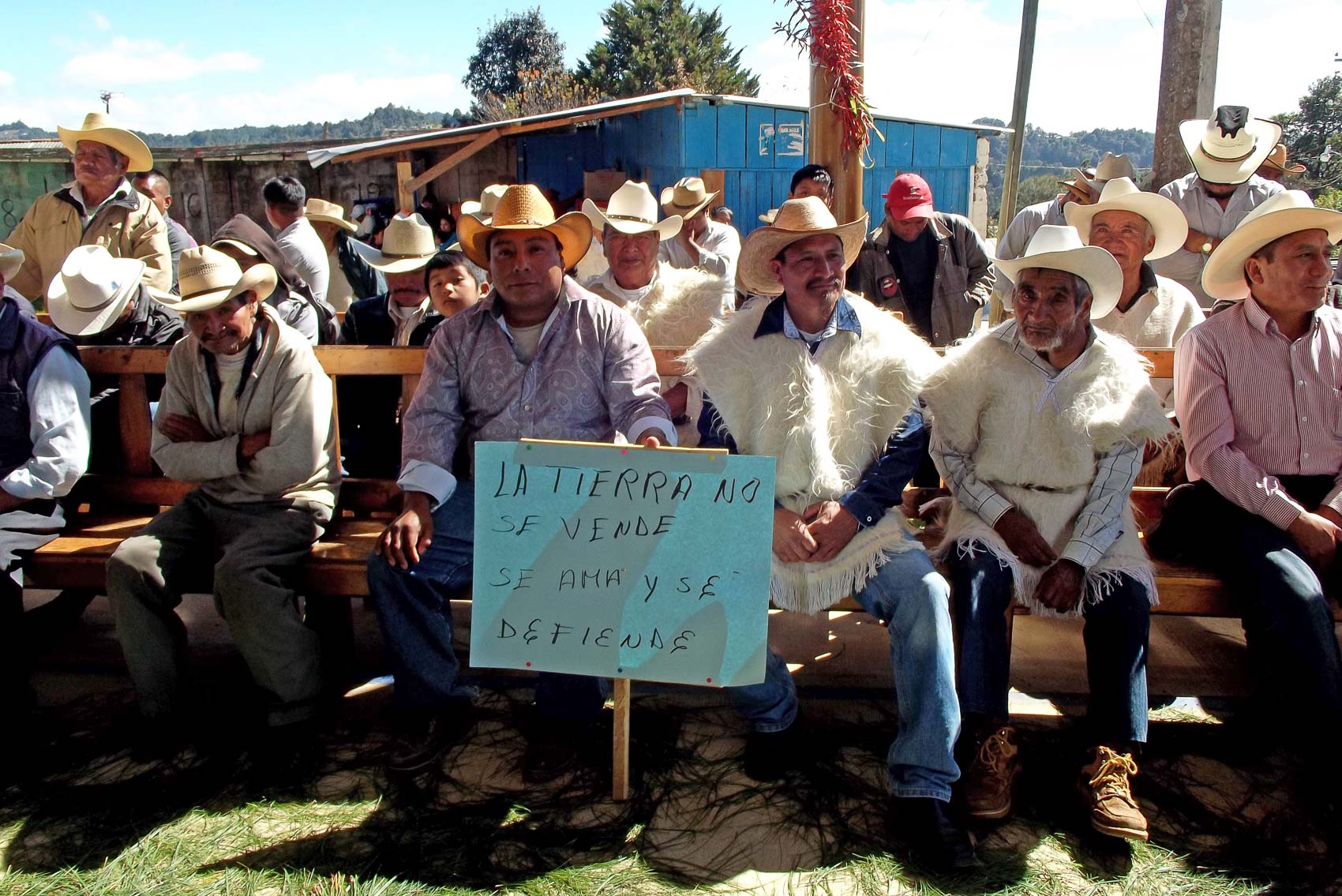
FOCUS: Megaprojects, a risk factor for those who defend territory
09/03/2023
O n January 9th and 10th, the 10th Summit of North American Leaders was held in Mexico City. Prior to the meeting, various civil organizations from the three countries sent a letter to the leaders of Mexico, the United States, and Canada requesting that they put on the table “the most urgent crises of our time: armed violence, environmental destruction, and the criminalization of migration.” Nevertheless, several analysts have underlined that the agreements reached responded more to the dynamics that have marked the relations between the three countries since the first commercial integration efforts in North America in the 1990s, with a growing emphasis on security aspects after the terrorist attacks of September 11th, 2001.
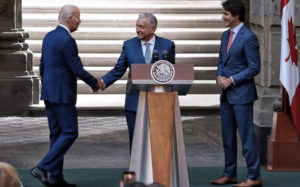
Joe Biden, Andrés Manuel López Obrador and Justin Trudeau – Xth Summit of North American Leaders © El Sol de México
The 10th Summit focused on six main axes: competitiveness, migration, security, diversity, health and environment, and climate change. From a rights perspective, an advance could be the approval of the declaration on equality and racial justice with a section on diversity, equity and inclusion towards African-American populations, indigenous peoples, women and LGBTQI+ people that states: “We focus on providing marginalized communities opportunities for their full, equitable and meaningful participation in our democracies and economies.” However, it does not raise many more factors that contribute to making these good intentions effective.
From Mexico, three topics addressed could be the ones that generate the greatest concern: economy, security and migration. In the economic bloc (competitiveness), the option continues to be North American integration as a trade block to compete in the global economy. Proposals were raised such as strengthening supply chains, dialogues to promote public and private foreign investment, a mapping of minerals in the region, and the creation of “sustainable” jobs. Several of these initiatives could lead to reinforcing the dependence of the Mexican economy on the United States, as well as the expansion of the extractivist model. On the other hand, and in advance, Foreign Minister Marcelo Ebrard had announced that the trade disputes presented by the US and Canada against Mexico under the current United States-Mexico-Canada Agreement (USMCA) were not going to be discussed at the summit. However, they are worrisome aspects. In 2022, the Biden government began consultations on the Mexican reforms in the energy sector, especially the one that gives priority to Mexican parastate companies. Likewise, senators linked to agribusiness interests in the US are calling for consultations against the Mexican ban on imports of transgenic corn and glyphosate.
As regards security, it is noteworthy that shortly before the Summit, Ovidio Guzman, son of El Chapo Guzman and member of the Sinaloa cartel, was arrested in Culiacan, an operation that caused at least 29 deaths and multiple injuries. The Declaration of the 10th Summit speaks explicitly of “our shared security perimeter” and the emphasis was on the fight against organized crime, maintaining a confrontational approach. On the other hand, little was said about arms trafficking coming from the US when it is estimated that more than 70% of those used in homicides in Mexico come from this country.
The Migration issue ultimately did not lead to a major change compared to the policy that has been followed despite its harsh consequences in terms of human rights. The program initiated by Trump that denies the right to request asylum to thousands of migrants will be maintained (Biden’s expansion also incorporated Venezuelans, Cubans, Nicaraguans and Haitians into the rejection mechanism). Mexico agreed to accept 30,000 returnees from these countries a month without mentioning how their rights would be guaranteed. Although there was talk of cooperating for a “safe, orderly, and humane” migration and “expanding regular pathways, strengthening asylum processes, and promoting a balanced public narrative”, they did not announce funds or clear mechanisms for it.
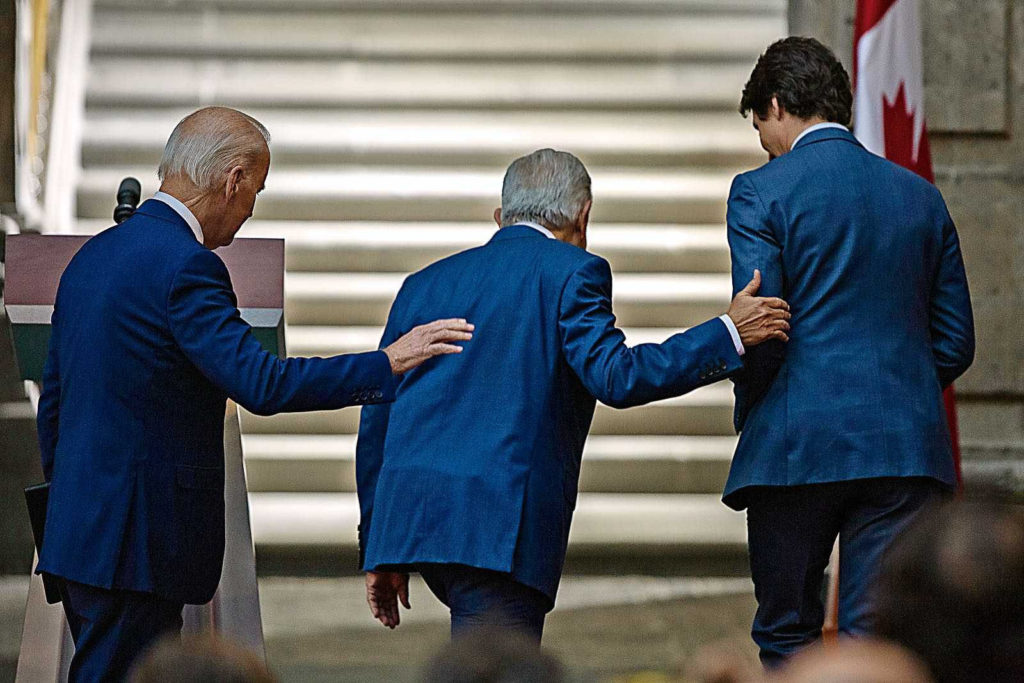
Joe Biden, Andrés Manuel López Obrador and Justin Trudeau – Xth Summit of North American Leaders © Manuel Giménez / Proceso
NATIONAL: Disappearances, vulnerability of human rights defenders and militarization, among the great pending issues in terms of human rights
Six-year term after six-year term, the crisis of disappearance of persons in Mexico has worsened. In 2018, the year in which the General Law on the disappearance of persons came into force, 46,423 cases were reported; at the end of 2022 the figure rose to 109,000. Since the year it came into force, 32 local search commissions have been created and installed. In addition, the Approved Protocol for the Search for Persons and the National Registry of Disappeared Persons entered into force. Despite this, “not all the mechanisms are working fully and there is still a lack of coordination between agencies”, denounced the Movement for Our Disappeared. Among the mechanisms contemplated are also the National Forensic Data Bank, the National Exhumations and Forensic Identification Program, as well as the National Registry of unidentified and unclaimed deceased persons, responsibilities of the Attorney General’s Office of the Republic (FGR). However, a judge ruled that this body has failed in its obligations. The FGR appealed the decision and argued that it lacks competence to implement such mechanisms.
Given the limitations to date, the United Nations High Commissioner for Human Rights (UNHCHR), Volker Türk, said that Mexico “has not yet acted firmly to combat this atrocious crime that affects hundreds of thousands of people.” “Disinformation and insensitivity to these crimes continue to be widespread among many public officials and the criteria for determining their responsibility are not adequately applied”, he added.
On another note, according to EDUCA, from December 2018 to November 2022, 141 human rights defenders were murdered in Mexico. Most of these crimes remain in total impunity so far. Of these cases, 34 have occurred in Oaxaca, followed by Guerrero with 25, Chiapas with 14 and Chihuahua with ten. Among the main issues for which they were assassinated is the defense of the Land and Territory against investments and development projects. Most belonged to an indigenous people.
In January, the Mexico Cerezo Committee reported that in 2022 it had documented 25 extrajudicial executions of human rights defenders. It stressed that in the last three six-year terms they have registered 335 cases, the largest number of these appearing during the Peña Nieto government (56%) followed by that of Andres Manuel Lopez Obrador (24%) and that of Calderon (20%). Most of the cases were again defenders of land and territory.
The beginning of 2023 was particularly violent for the activists, according to Aluna Psychosocial Accompaniment, which registered four murders, two disappearances and 12 arbitrary detentions up to January 17th.
Outlining another trend in current vulnerability, in February, the All Rights for All Network (Red TdT) reported that, in January, the Inter-American Commission on Human Rights (IACHR) issued precautionary measures in three cases in states where “macrocriminality has gained ground and the collusion of authorities aggravates insecurity and impunity.” It explained that the measures were granted in favor of Ricardo Arturo Lagunes Gasca and Antonio Diaz Valencia in Michoacan; the Jesuit community of Cerocahui in Chihuahua and Pascuala Lopez and her family nucleus in Chiapas. Red TdT declared that “the reality goes beyond morning speeches and official reports and internal resources offered by the Mexican State; they have been exhausted and insufficient to give answers to family members, communities and collectives that demand justice and truth.”
Finally, as regards militarization, in November, the Supreme Court of Justice of the Nation (SCJN) endorsed the agreement through which AMLO ordered the permanence of the Army in public security tasks. In 2020, PAN member Laura Rios had filed a constitutional appeal on the grounds that President Lopez Obrador invaded the powers of the Legislative Branch by publishing said agreement. Given the Court’s ruling, the Mexico Office of the United Nations High Commissioner for Human Rights (UNHCHR) expressed that it could exacerbate the “already high level of violence” and favor human rights violations, referring to concerns previously indicated by experts of the organization. Likewise, the Miguel Agustin Pro Juarez Human Rights Center (Centro Prodh) affirmed that “an opportunity was lost for the Judiciary to act as a counterweight to the militarization in the country.” Likewise, it called on the Court to address the other cases of unconstitutionality that have been filed on this same issue.
CHIAPAS: Climate of generalized violence
In January, more than 5,000 Catholics from different municipalities of the Diocese of San Cristobal de Las Casas made a pilgrimage in this city. In a statement, they pointed out the presence of organized crime “in a context of dispute and control of the territory, leading us to a climate of generalized violence, threats, confrontations, disappearances and murders (…) as well as the recruitment of young people.” In addition, it highlighted the permissiveness and collusion of the authorities with these players, generating impunity and injustice. “We demand an end to the destruction of families through violence, displacement, kidnapping, the dispossession of territory, and the insecurity that is growing with the increase in weapons and the presence of organized crime. We demand respect for women in all areas of society; that their right to decide freely is not impeded. We demand that the fight to defend the self-determination of our peoples and the defense of the territory be stopped from being criminalized”, Believing People said.
Similarly, in January, hundreds of people marched in Chicomuselo “to demand an end to the violence unleashed by organized crime that intends to impose mining in the region with the complicit silence of the authorities.” In the “March for Life”, ejido and community representatives denounced that since mid-2022 a barite mine began to operate illegally in the Santa Maria ejido, which “has its precedent with the concession of the Canadian company BlackFire, which tried to settle in the ejido Grecia in 2009 and which stopped its operations after the murder of the defender of the territory Mariano Abarca.”
The protesters also denounced that “the violence carried out on behalf of this mining company by an organized crime group called MAIZ, which has traveled through the communities with high- caliber weapons to intimidate the population and warn them that if they oppose the mining, they will harm them and, by the way, they have begun to collect “protection money” for trade and transportation.” In the march, the participants demanded the protection of life and integrity of the defenders of Mother Earth, in particular Isabel Recinos Trigueros, who was attacked in December.
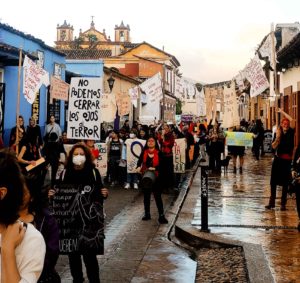
International Day for the Elimination of Violence against Women, San Cristóbal de Las Casas, November 2022 © SIPAZ
Later, in this same region, through a video, hooded men with bullet-proof vests and high-caliber weapons announced the creation of a self-defense group called the “Indigenous Council” due to the lack of response from the authorities to the growing wave of violence. The group points to people linked to the Jalisco New Generation Cartel (CJNG) as responsible for these crimes. It indicated that they will not allow the cartel to enter the indigenous communities. “We also address our brothers from Chicomuselo, that we will support them and we will not leave them alone because they are being harassed by the organization called El Maiz, dedicated to extortion and many of our indigenous brothers have disappeared”, it declared.
Finally, in February, 42 families had to flee their homes in the Ejido Saltillo in the nearby municipality of Las Margaritas. They denounced that a group of people supposedly belonging to the Alliance of Social Organizations and Unions of the Left (ASSI), an organization that is said to be related to the mayor of Las Margaritas, Bladimir Hernandez Alvarez, entered the Ejido armed with clubs, machetes and firearms, they burned 27 houses and destroyed others, killed animals and expelled these families. The displaced persons “indicated that for not resigning from the Independent Central of Agricultural and Peasant Workers-Historical (CIOAC-Historical) to which they belong and joining ASSI is why they proceeded to expel them from their homes and threatened them not to return.”
Another violence to overcome: gender violence. In November, within the framework of the International Day for the Elimination of Violence against Women, women took to the streets to demand safety and justice. In the statement that they read at the end of their mobilization, they pointed out that so far this year, 345 girls and adolescents had disappeared in the state, almost eight per week. In addition, “by analyzing newspaper articles, we found at least 53 cases that have all the characteristics to be considered femicide”, said the Feminist Observatory against Violence against Women of Chiapas. Chiapas currently ranks fifth nationally for this crime and, according to the organization For the Rise of Women, six out of ten femicides that occur in Chiapas go unpunished.
OAXACA: New governor takes office in a complex context
On December 1st, Salomon Jara Cruz, the first governor to come from the National Regeneration Movement (MORENA) in this state, took office as governor of Oaxaca. Originally from an indigenous community, he comes from the traditional left. After the disappointing center-left experience of Gabino Cue (2010-2016), his origins did not arouse the same hopes for change in the population: only 38% of the electorate participated in the vote that allowed him to become governor. In addition, it has been assessed that the votes in his favor were more linked to his belonging to President Lopez Obrador’s party than to his own charisma. Undoubtedly, he inherits a state lacerated by poverty, violence, insecurity and multiple political-social conflicts, in addition to a debt that will not facilitate the search for alternatives.
A large part of the socio-political conflicts in the state derive from agrarian problems and mega-projects that part of the local population rejects. In January, the Front of Oaxacan Organizations (FORO) made up of ten social organizations, organized the forum “The Oaxacan Situation, Challenges for the Popular Movement.” The participants rejected the imposition of megaprojects such as the Maya Train, the Morelos Integral Project (PIM) and the Interoceanic Corridor, since “they actually constitute a single megaproject that seeks to reconfigure the Mexican south-east for the benefit of big capital over and above the interests of the peoples.” They stressed that these intentions are protected by “decrees” and by resorting to the Army and the Navy to take care of their facilities.
Along the same lines, in February, various communities, ejidos, and other groups mobilized in the Tehuantepec Isthmus, summoned by the National Civil Resistance Network, to carry out dislocated actions throughout the country for a fair electricity rate, against the imposition of the Interoceanic Corridor, militarization and the “death megaprojects”. In this context, they denounced the climate of violence, persecution, criminalization, harassment, and aggression against the inhabitants of Puente Madera and the Assembly of Indigenous Peoples of the Isthmus in Defense of Land and Territory (APIIDTT).
New sources of tension could arise. In February, Andres Manuel Lopez Obrador announced that four new industrial parks for the generation of wind energy will be built on the Isthmus. They will be managed by the Federal Electricity Commission (CFE) with financing from the United States Bank, as this initiative is part of the agreement established with this country regarding actions to curb climate change. It would be a first round of bidding. These four parks will be added to the 29 that are already in operation on the Isthmus and have generated different levels of opposition.
Another cause for concern on the part of civil organizations in the state: the exacerbation of gender violence. In November, a series of activities was organized within the framework of the commemoration of the International Day for the Elimination of Violence against Women. In a statement supported by 34 organizations and relatives of victims, they recalled that although in 2018, a Gender Violence Alert against Women in Oaxaca was issued due to the seriousness of the situation, there has been “no forceful action to eradicate and punish of violence against women; Since then, 498 women have been victims of femicide, 1,672 of disappearances.”
Likewise, a few days from the change of governor, they claimed that the mandate of Alejandro Murat, the outgoing governor, had been “a six-year period of mourning.” In this period, they documented 715 women victims of femicide, while 1,989 women (including girls) were victims of forced disappearance or other acts of violence (for example: sexual crimes, family violence, economic violence or gender politics). With this, a total of 3,965 women suffered some type of aggression during his tenure.
GUERRERO: “Bleak” state panorama
At the beginning of 2023, La Montaña Tlachinollan Mountain Human Rights Center published a bulletin entitled “Between Ephemeral Spectacle and Permanent Violence” in which it contrasted the “golden dream that thousands of national and foreign tourists enjoyed” on New Year in Acapulco and the violence that is lived in the periphery and the other regions of the state of Guerrero. It pointed out that “the great social contrasts that exist in Acapulco, instead of being reversed, have deepened. Corruption has no control. The municipal administrations are managed in a factious manner and in opacity.” It added that “the absence of public institutions to meet the most basic needs is worrisome. This vacuum of authority has been filled by the bosses of organized crime, which exercises control of various lines of business and has under its control groups of transporters, street vendors and settlers who impose their law and work for their cause.”
It further stated that “the entire route that reaches the state capital has become a permanent dispute over the transfer of drugs. This expansion has claimed lives and the most serious thing is that the municipal authorities prefer to close their eyes or ally with these groups to guarantee relative governability.” Tlachinollan also expressed that “the state panorama is bleak not only because of the violence that is expanding, but also because of the growing power of criminal organizations that have settled in various regions and have shown they even have control of the town halls. They are part of the economic players that with their illegal activities have ventured into basic businesses to launder money and at the same time strengthen their presence in regions and communities where there are no government institutions or programs that meet the most basic needs. The returns of the criminal economy have multiplied and now they are preparing to control even the basic products. In several regions this phenomenon is already a reality that has the general population trapped in its claws”.
The cases of femicides are equally alarming: at least 15 were registered in January. Within the framework of the International Day to Eliminate Violence against Women in November, the Association of Guerrero Against Violence against Women (AGCVM) and other feminist and family groups of victims denounced “the simulation that persists in government agencies and different levels of government.”
In this context, human rights defenders and journalists continue to face a highly vulnerable situation. In December, the Council of Ejidos and Communities Opposing La Parota Dam (CECOP) denounced the arbitrary detention and torture of two of its members, Modesto and Rodrigo Leon Jacinto. More than 130 civil and social organizations demanded their release and the “cessation of the acts of harassment and criminalization of the members of the CECOP.” They declared that “it is really worrying that in the state of Guerrero these repressive acts against activists who defend the natural commons continue.”
On another note, in January, journalists protested in Chilpancingo and Acapulco to demand that they intensify the search for journalist Jesus Pintor Alegre and the administrators of the Facebook page of Escenario Calenarion, Fernando Moreno and Alan Garcia, who had disappeared since December. When they were released, they indicated that they were accused by their captors of disseminating information on their website that pointed to the criminal association La Familia Michoacana and to mayors of the region due to their alleged closeness to the criminal gang.
In the Ayotzinapa case, in January, the United States authorities handed over to Mexico Alejandro Tenescalco, supervisor of the Iguala police during the attack against Ayotzinapa student teachers, in September 2014. Likewise, in January, members of the Interdisciplinary Group of Independent Experts (IGIE) in the case met privately with Lopez Obrador and Alejandro Encinas, undersecretary for Human Rights, Population and Migration, who, according to the media, asked them to mediate so that the Army finishes handing over the information that it was asked for, that the Prosecutor’s Office reactivate the 21 arrest warrants canceled last year, as well as speed up other arrests in the United States.

